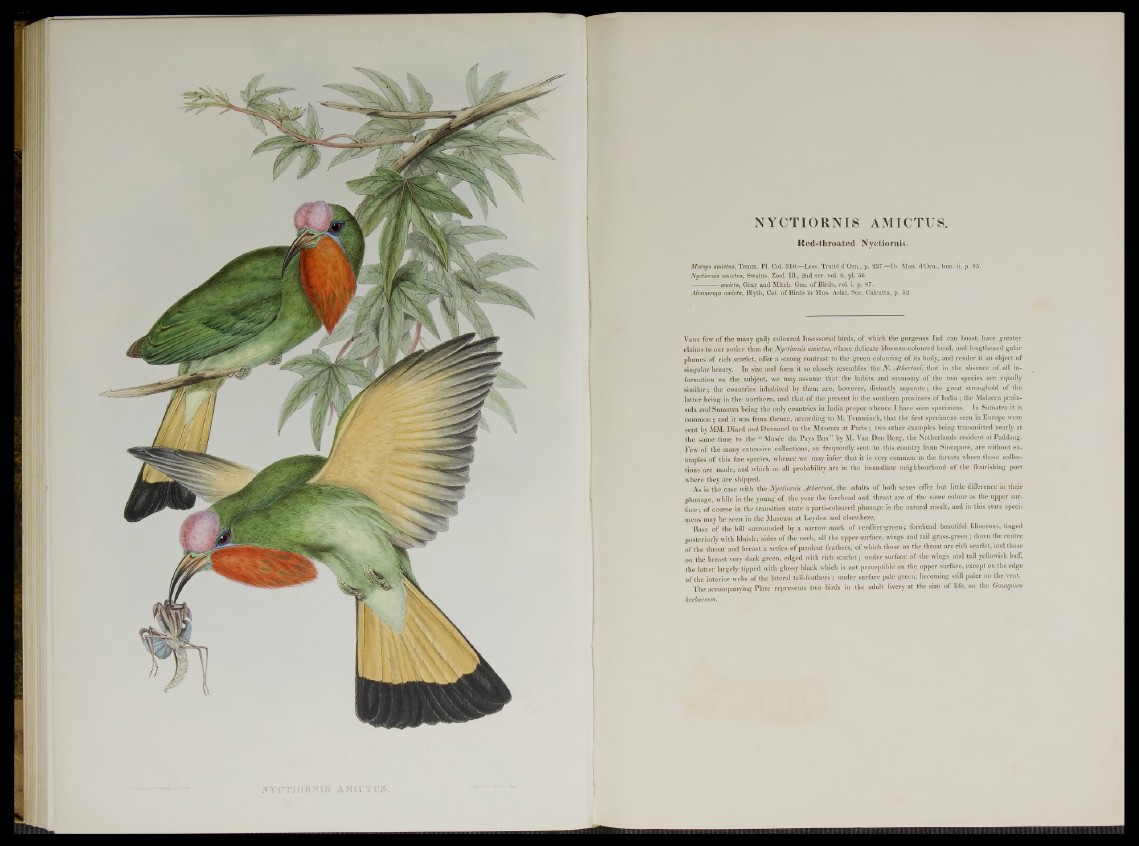
NYCTIORNIS AMICTUS.
Red -th ro a ted Nyctiornis.
Merops amictus, Temm. Pl. Col. 310.—Less. Traité d’Orn., p. 237.—lb. Man. d’Orn., tom. ii. p. 85.
Nyctiornis amictus, Swains. Zool. 111., 2nd ser. vol. ii. pl. 56.
■— amicta, Gray and Mitch. Gen. of Birds, vol. i. p. 87.
Alcemerops amicta, Blyth, Cat. of Birds in Mus. Asiat. Soc. Calcutta, p. 52.
Very few of the many gaily coloured Insessorial birds, of which the gorgeous Ind can boast, have greater
claims to our notice than the Nyctiornis amictus, whose delicate blossom-coloured head, and lengthened guiar
plumes of rich scarlet, offer a strong contrast to the green colouring of its body, and render it an object of
singular beauty. In size and form it so closely resembles the N. Athertoni, that in the absence of all information
on the subject, we may assume that the habits and economy of the two species are equally
similar; the countries inhabited by them are, however, distantly separate; the great stronghold of the
latter being in the northern, and that of the present in the southern provinces of India; the Malacca peninsula
and Sumatra being the only countries in India proper whence I have seen specimens. In Sumatra it is
common ; and it was from thence, according to M. Temminck, that the first specimens seen in Europe were
sent by MM. Diard and Duvaucel to the Museum at Paris ; two other examples being transmitted nearly at
the same time to the “ Musée du Pays Bas ” by M. Van Den Berg, the Netherlands resident at Paddang.
Few of the many extensive collections, so frequently sent to this country from Sincapore, are without examples
of this fine species, whence we may infer that it is very common in the forests where those collections
are made, and which in all probability are in the immediate neighbourhood of the flourishing port
where they are shipped.
As is the case with the Nyctiornis Athertoni, the adults of both sexes offer but little difference in their
plumage, while in the young of the year the forehead and throat are of the same colour as the upper surface;
of course in the transition state a parti-coloured plumage is the natural result, and in this state specimens
may be seen in the Museum at Leyden and elsewhere.
Base of the bill surrounded by a narrow mark of verditer-green; forebead beautiful liliaceous, tinged
posteriorly with bluish; sides of the neck, all the upper surface, wings and tail grass-green ; down the centre
of the throat and breast a series of pendent feathers, of which those on the throat are rich scarlet, and those
on the breast very dark green, edged with rich scarlet; under surface of the wings and tail yellowish buff,
the latter largely tipped with glossy black which is not perceptible On the upper surface, except on the edge
of the interior webs of the lateral tail-feathers ; under surface pale green, becoming still paler on the vent.
The accompanying Plate represents two birds in the adult livery at the size of life, on the Gossypium
herbaceum.